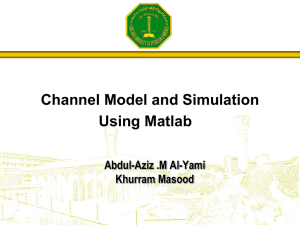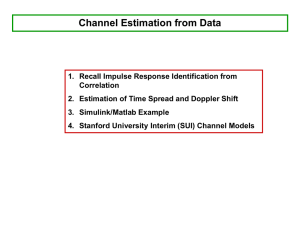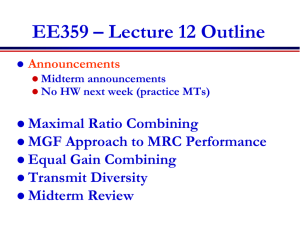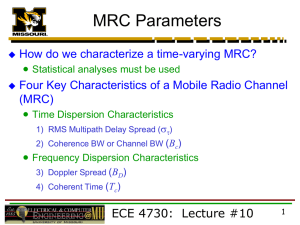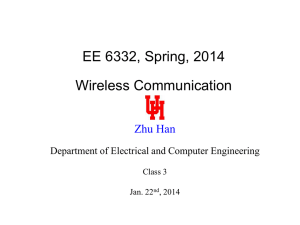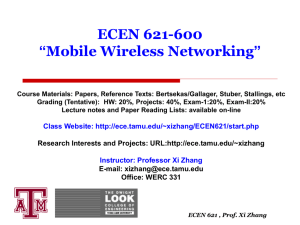Lecture 6 Fading
advertisement
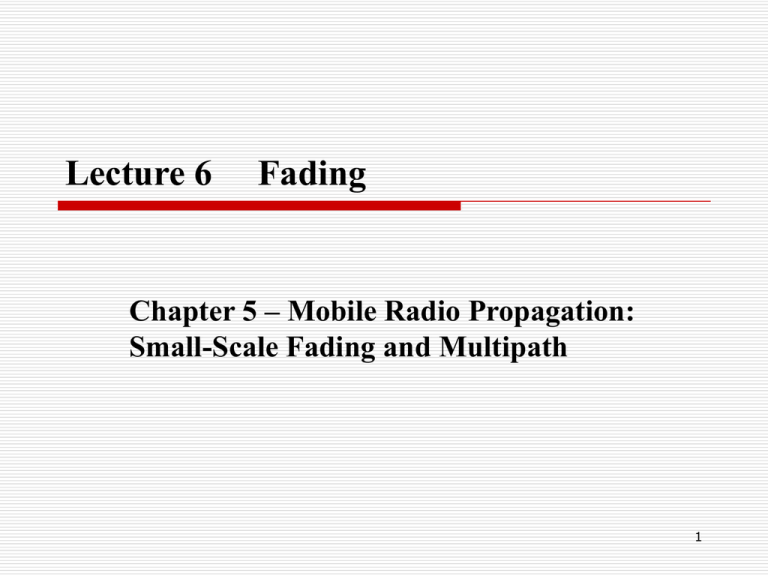
Lecture 6 Fading Chapter 5 – Mobile Radio Propagation: Small-Scale Fading and Multipath 1 Last lecture Large scale propagation properties of wireless systems - slowly varying properties that depend primarily on the distance between Tx and Rx. Free space path loss Power decay with respect to a reference point The two-ray model General characterization of systems using the path loss exponent. Diffraction Scattering This lecture: Rapidly changing signal characteristics primarily caused by movement and multipath. 2 I. Fading Fading: rapid fluctuations of received signal strength over short time intervals and/or travel distances Caused by interference from multiple copies of Tx signal arriving @ Rx at slightly different times Three most important effects: 1. Rapid changes in signal strengths over small travel distances or short time periods. 2. Changes in the frequency of signals. 3. Multiple signals arriving a different times. When added together at the antenna, signals are spread out in time. This can cause a smearing of the signal and interference between bits that are received. 3 Fading signals occur due to reflections from ground & surrounding buildings (clutter) as well as scattered signals from trees, people, towers, etc. often an LOS path is not available so the first multipath signal arrival is probably the desired signal (the one which traveled the shortest distance) allows service even when Rx is severely obstructed by surrounding clutter 4 Even stationary Tx/Rx wireless links can experience fading due to the motion of objects (cars, people, trees, etc.) in surrounding environment off of which come the reflections Multipath signals have randomly distributed amplitudes, phases, & direction of arrival vector summation of (A ∠θ) @ Rx of multipath leads to constructive/destructive interference as mobile Rx moves in space with respect to time 5 received signal strength can vary by Small-scale fading over distances of a few meter (about 7 cm at 1 GHz)! This is a variation between, say, 1 mW and 10-6 mW. If a user stops at a deeply faded point, the signal quality can be quite bad. However, even if a user stops, others around may still be moving and can change the fading characteristics. And if we have another antenna, say only 7 to 10 cm separated from the other antenna, that signal could be good. This is called making use of ________ which we will study in Chapter 7. 6 fading occurs around received signal strength predicted from large-scale path loss models 7 II. Physical Factors Influencing Fading in Mobile Radio Channel (MRC) 1) Multipath Propagation # and strength of multipath signals time delay of signal arrival large path length differences → large differences in delay between signals urban area w/ many buildings distributed over large spatial scale large # of strong multipath signals with only a few having a large time delay suburb with nearby office park or shopping mall moderate # of strong multipath signals with small to moderate delay times rural → few multipath signals (LOS + ground reflection) 8 2) Speed of Mobile relative motion between base station & mobile causes random frequency modulation due to Doppler shift (fd) Different multipath components may have different frequency shifts. 3) Speed of Surrounding Objects also influence Doppler shifts on multipath signals dominates small-scale fading if speed of objects > mobile speed otherwise ignored 9 4) Tx signal bandwidth (Bs) The mobile radio channel (MRC) is modeled as filter w/ specific bandwidth (BW) The relationship between the signal BW & the MRC BW will affect fading rates and distortion, and so will determine: a) if small-scale fading is significant b) if time distortion of signal leads to inter-symbol interference (ISI) An MRC can cause distortion/ISI or small-scale fading, or both. But typically one or the other. 10 Doppler Shift motion causes frequency modulation due to Doppler shift (fd) v : velocity (m/s) λ : wavelength (m) θ : angle between mobile direction and arrival direction of RF energy + shift → mobile moving toward S − shift → mobile moving away from S 11 Two Doppler shifts to consider above 1. The Doppler shift of the signal when it is received at the car. 2. The Doppler shift of the signal when it bounces off the car and is received somewhere else. Multipath signals will have different fd’s for constant v because of random arrival directions!! 12 Example 5.1, page 180 Carrier frequency = 1850 MHz Vehicle moving 60 mph Compute frequency deviation in the following situations. (a) Moving directly toward the transmitter (b) Moving perpendicular to the transmitter 13 Note: What matters with Doppler shift is not the absolute frequency, but the shift in frequency relative to the bandwidth of a channel. For example: A shift of 166 Hz may be significant for a channel with a 1 kHz bandwidth. In general, low bit rate (low bandwidth) channels are affected by Doppler shift. 14 III. MRC Impulse Response Model Model the MRC as a linear filter with a time varying characteristics Vector summation of random amplitudes & phases of multipath signals results in a "filter" That is to say, the MRC takes an original signal and in the process of sending the signal produces a modified signal at the receiver. 15 Time variation due to mobile motion → time delay of multipath signals varies with location of Rx Can be thought as a "location varying" filter. As mobile moves with time, the location changes with time; hence, time-varying characteristics. The MRC has a fundamental bandwidth limitation → model as a band pass filter 16 Linear filter theory y(t) = x(t) ⊗ h(t) or Y ( f ) = X( f ) ⋅H ( f ) How is an unknown h(t) determined? let x(t) = δ(t) → use a delta or impulse input y(t) = h(t) → impulse response function Impulse response for standard filter theory is the same regardless of when it is measured → time invariant! 17 18 How is the impulse response of an MRC determined? “channel sounding” → like radar transmit short time duration pulse (not exactly an impulse, but with wide BW) and record multipath echoes @ Rx 19 short duration Tx pulse ≈ unit impulse define excess delay bin as i 1 i amplitude and delay time of multipath returns change as mobile moves Fig. 5.4, pg. 184 → MRC is time variant 20 model multipath returns as a sum of unit impulses ai ∠ θ i = amplitude & phase of each multipath signal N = # of multipath components ai is relatively constant over an local area But θ i will change significantly because of different path lengths (direct distance plus reflected distance) at different locations. 21 The useful frequency span of the model : 2 / The received power delay profile in a local area: P( ) k hb (t ; ) 2 Assume the channel impulse response is time invariant, or WSS 22 Relationship between Bandwidth and Received Power A pulsed, transmitted RF signal of the form 23 For wideband signal 24 The average small-scale received power The average small scale received power is simply the sum of the average powers received in each multipath component The Rx power of a wideband signal such as p(t) does not fluctuate significantly when a receiver is moved about a local area. 25 CW signal (narrowband signal ) is transmitted in to the same channel 26 Average power for a CW signal is equivalent to the average received power for a wideband signal in a small-scale region. The received local ensemble average power of wideband and narrowband signals are equivalent. Tx signal BW > Channel BW very small Rx power varies Tx signal BW < Channel BW fluctuations (fading) occur large signal The duration of baseband signal > excess delay of channel due to the phase shifts of the many unsolved multipath components 27 28 The Fourier Transform of hb ( t,τ) gives the spectral characteristics of the channel → frequency response MRC filter passband → “Channel BW” or Coherence BW = Bc range of frequencies over which signals will be transmitted without significant changes in signal strength channel acts as a filter depending on frequency signals with narrow frequency bands are not distorted by the channel 29 30 31 32 33 34 35 IV. Multipath Channel Parameters Derived from multipath power delay profiles (Eq. 5-18) P (τk) : relative power amplitudes of multipath signals (absolute measurements are not needed) Relative to the first detectable signal arriving at the Rx at τ0 use ensemble average of many profiles in a small localized area →typically 2 − 6 m spacing of measurements→ to obtain average smallscale response 36 37 Time Dispersion Parameters “excess delay” : all values computed relative to the time of first signal arrival τo mean excess delay → RMS delay spread → where Avg( τ2) is the same computation as above as used for except that A simple way to explain this is “the range of time within which most of the delayed signals arrive” 38 outdoor channel ~ on the order of microseconds indoor channel ~ on the order of nanoseconds 39 maximum excess delay ( τX): the largest time where the multipath power levels are still within X dB of the maximum power level worst case delay value depends very much on the choice of the noise threshold 40 τ and στ provide a measure of propagation delay of interfering signals Then give an indication of how time smearing might occur for the signal. A small στ is desired. The noise threshold is used to differentiate between received multipath components and thermal noise 41 42 43 Coherence BW (Bc) and Delay Spread ( ) The Fourier Transform of multipath delay shows frequency (spectral) characteristics of the MRC Bc : statistical measure of frequency range where MRC response is flat MRC response is flat = passes all frequencies with ≈ equal gain & linear phase amplitudes of different frequency components are correlated if two sinusoids have frequency separation greater than Bc, they are affected quite differently by the channel 44 amplitude correlation → multipath signals have close to the same amplitude → if they are then out-of-phase they have significant destructive interference with each other (deep fades) so a flat fading channel is both “good” and “bad” Good: The MRC is like a bandpass filter and passes signals without major attenuation from the channel. Bad: Deep fading can occur. 45 so the coherence bandwidth is “the range of frequencies over which two frequency components have a strong potential for amplitude correlation.” (quote from textbook) 46 estimates 0.9 correlation → Bc ≈ 1 / 50 (signals are 90% correlated with each other) 0.5 correlation → Bc ≈ 1 / 5 Which has a larger bandwidth and why? specific channels require detailed analysis for a particular transmitted signal – these are just rough estimates 47 A channel that is not a flat fading channel is called frequency selective fading because different frequencies within a signal are attenuated differently by the MRC. Note: The definition of flat or frequency selective fading is defined with respect to the bandwidth of the signal that is being transmitted. 48 Bc and στ are related quantities that characterize time-varying nature of the MRC for multipath interference from frequency & time domain perspectives 49 50 51 these parameters do NOT characterize the time-varying nature of the MRC due to the mobility of the mobile and/or surrounding objects that is to say, Bc and characterize the statics, (how multipath signals are formed from scattering/reflections and travel different distances) Bc and στ do not characterize the mobility of the Tx or Rx. 52 Doppler Spread (BD) & Coherence Time (Tc) BD : measure of spectral broadening of the Tx signal caused by motion → i.e., Doppler shift BD = max Doppler shift = fmax = vmax / λ In what direction does movement occur to create this worst case? if Tx signal bandwidth (Bs) is large such that Bs >> BD then effects of Doppler spread are NOT important so Doppler spread is only important for low bps (data rate) applications (e.g. paging) 53 Tc : statistical measure of the time interval over which MRC impulse response remains invariant → amplitude & phase of multipath signals ≈ constant Coherence Time (Tc) = passes all received signals with virtually the same characteristics because the channel has not changed time duration over which two received signals have a strong potential for amplitude correlation 54 Two signals arriving with a time separation greater than Tc are affected differently by the channel, since the channel has changed within the time interval For digital communications coherence time and Doppler spread are related by Tc 9 16 f m2 0.423 fm 55 V. Types of Small-Scale Fading Fading can be caused by two independent MRC propagation mechanisms: 1) time dispersion → multipath delay (Bc , ) 2) frequency dispersion → Doppler spread (BD , Tc) Important digital Tx signal parameters → symbol period & signal BW 56 A pulse can be more than two levels, however, so each period would be called a "symbol period". We send 0 (say +1 Volt) or 1 (say -1 Volt) → one bit per “symbol” Or we could send 10 (+3 Volts) or 00 (+1 Volt) or 01 (-1 Volt) or 11 (-3 Volts) → two bits per “symbol” 57 illustrates types of small-scale fading 58 1) Fading due to Multipath Delay A)Flat Fading → Bs << Bc or Ts >> Ts 10 signal fits easily within the bandwidth of the channel channel BW >> signal BW most commonly occurring type of fading 59 spectral properties of Tx signal are preserved signal is called a narrowband channel, since the bandwidth of the signal is narrow with respect to the channel bandwidth signal is not distorted What does Ts >> mean?? all multipath signals arrive at mobile Rx during 1 symbol period ∴ Little intersymbol interference occurs (no multipath components arrive late to interfere with the next symbol) 60 61 flat fading is generally considered desirable Even though fading in amplitude occurs, the signal is not distorted Forward link → can increase mobile Rx gain (automatic gain control) Reverse link → can increase mobile Tx power (power control) Can use diversity techniques (described in a later lecture) 62 B) Frequency Selective Fading → Bs > Bc or Ts < Ts 10 Bs > Bc → certain frequency components of the signal are attenuated much more than others 63 64 Ts < στ → delayed versions of Tx signal arrive during different symbol periods e.g. receiving an LOS → “1” & multipath “0” (from prior symbol!) This results in intersymbol interference (ISI) Undesirable it is very difficult to predict mobile Rx performance with frequency selective channels 65 But for high bandwidth applications, channels with likely be frequency selective a new modulation approach has been developed to combat this. Called OFDM One aspect of OFDM is that it separates a wideband signal into many smaller narrowband signals Then adaptively adjusts the power of each narrowband signal to fit the characteristics of the channel at that frequency. Results in much improvement over other wideband transmission approaches (like CDMA). 66 OFDM is used in the new 802.11g 54 Mbps standard for WLAN’s in the 2.4 GHz band. Previously it was thought 54 Mbps could only be obtained at 5.8 GHz using CDMA, but 5.8 GHz signals attenuate much more quickly. Signals are split using signal → FFT, break into pieces in the frequency domain, use inverse FFT to create individual signals from each piece, then transmit. 67 2) Fading due to Doppler Spread Caused by motion of Tx and Rx and reflection sources. A) Fast Fading → Bs < BD or Ts > Tc Bs < BD Doppler shifts significantly alter spectral BW of TX signal signal “spreading” Ts > Tc MRC changes within 1 symbol period rapid amplitude fluctuations uncommon in most digital communication systems 68 B) Slow Fading → Ts << Tc or Bs >> BD MRC constant over many symbol periods slow amplitude fluctuations for v = 60 mph @ fc = 2 GHz → BD = 178 Hz ∴ Bs ≈ 2 kHz >> BD Bs almost always >> BD for most applications ** NOTE: Typically use a factor of 10 to designate “>>” ** 69 70 VI. Fading Signal Distributions Rayleigh probability distribution function → r2 P(r ) 2 exp 2 2 r 0r Used for flat fading signals. Formed from the sum of two Gaussian noise signals. σ : RMS value of Rx signal before detection (demodulation) common model for Rx signal variation urban areas → heavy clutter → no LOS path probability that signal does not exceeds predefined threshold level R 71 72 rmean : The mean value of Rayleigh distribution 0 2 rmean E[r ] rp(r )dr 1.2533 σr2 : The variance of Rayleigh distribution; ac power of signal envelope r2 E[r 2 ] E 2 [r ] r 2 p(r )dr 0 2 2 2 0.4292 2 2 2 σ : RMS value of Rx signal before detection (demodulation) 73 74 Ricean Probability Distribution Function one dominant signal component along with weaker multipath signals dominant signal → LOS path suburban or rural areas with light clutter becomes a Rayleigh distribution as the dominant component weakens 75 76 The remainder of Chapter 5 gives many models for correlating measured data to a model of an MRC. Nothing else in Chapter 5 will be covered here, however. Next lecture: Modulation techniques particularly suited for mobile radio. 77 HW-4 5.6, 5.7, 5.16, 5.28, 5.31 78
